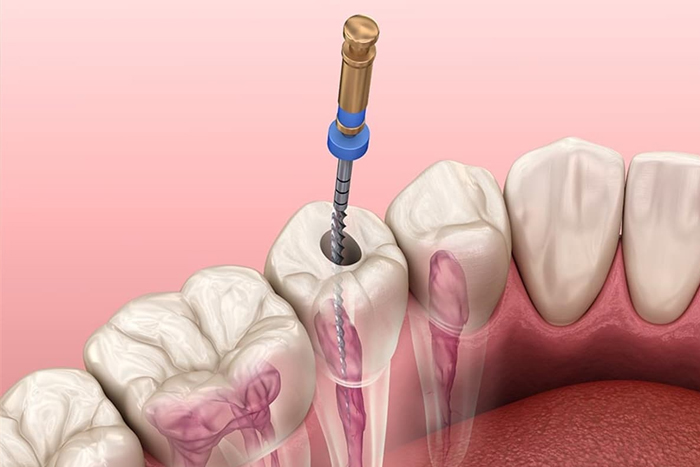
Root treatment
It is the treatment applied in cases where the tooth has decayed down to the innermost living pulp layer. Root canal treatment can be applied to any tooth. In cases where the tooth is infected and depending on the number of affected canals, the duration of treatment may be extended.
What is Root Canal Treatment?
Endodontic treatment, or root canal treatment, is the process of removing the pulp tissue that has become inflamed for various reasons or infected by the settlement of microorganisms, cleaning the root canal space, shaping it and filling it with tissue-friendly root canal filling materials. This whole process is defined as root canal treatment. Root canal treatment is a method applied in cases where the tooth root is affected by decay or various traumas. The aim here is to prevent tooth loss and to ensure that the tooth remains active in the jawbone by performing its normal functions.
In Which Cases Is Root Canal Treatment Performed?
Root canal treatment is applied when there is decay in the tooth or cracks in the tooth bone. In addition, root canal treatment can be applied in cases where the tooth is seriously damaged to save the dead tooth and not to lose the bone structure.
The tooth consists of 3 main layers. The outermost enamel of the tooth and the dentin layer under it form the hard surfaces of the tooth. On the inner surface of the tooth, there is a living pulp layer containing the blood vessels and nerves that feed the tooth. When tooth decay passes through all these layers and reaches the pulp, an infection develops in the tooth. This means that the pulp is damaged and the nerves here die.
Root canal treatment is a treatment performed to avoid losing a tooth. Tooth loss can cause the area to lose its activity and the jawbone to melt. In addition, tooth loss can negatively affect the patient in terms of aesthetics, social and psychological aspects. The process of cleaning the decay caused by the infection that has progressed to the pulp and root canals, shaping the canals and then filling the canal in a way that leaves no entrance is called root canal treatment. The aim here is to prevent the passage of matter from the tip of the tooth root into the mouth and from the mouth to the root tip. In very advanced cases, the infection can also affect the jawbone.
Is root canal treatment a painful procedure?
When a tooth decays, the tooth becomes vulnerable to external factors. The decay reaching the pulp, i.e. the tooth canals, causes infections and the root tip of the tooth opens into the mouth. Root canal treatment is a procedure that must be performed in order to save the tooth. It does not change depending on preference. Root canal treatment should be performed before filling the infected tooth. Root canal treatment is not a painful procedure. If the tooth is not necrotic and is still alive, root canal treatment is performed with local anesthesia.
How long does root canal treatment take?
The treatment period may vary depending on the number of canals in the tooth, its location in the mouth and the infection status. If there is no infection or cyst formation in the pulp, root canal treatment can be completed in a single session. Since the tooth usually comes with an infection, the treatment takes 2 sessions. A single session of root canal treatment can take up to 45 minutes. The tooth canal should be cleaned and shaped very well in the first session. Local medication is applied to the cleaned area to kill the harmful microorganisms there. If there is no inflammation in the canal during the second session of the root canal treatment, if there is no sensitivity in the patient’s tooth, if the x-ray is clean and if there is no disorder in the tissue surrounding the tooth, the tooth is filled.
What should be considered during and after the treatment?
Since the tooth that has undergone root canal treatment loses its vitality, the possibility of it breaking is higher. Therefore, very hard foods should not be consumed during the treatment and that tooth should not be used too much. Antibiotic drugs can be used to eliminate the infection. In case of possible pain, painkillers can also be recommended. After the treatment is over, the things that should be done after a normal filling should be done. Nothing should be eaten or drunk until the local anesthesia wears off. The patient may feel sensitivity for a day or two. The tooth that has undergone root canal treatment can be used for a lifetime. If the tooth has lost too much material during the root canal treatment, restorations can be made using various fillings to support the tooth, ensure its function and extend the life of the tooth. In order to protect oral and dental health after root canal treatment, the teeth should be brushed twice a day, and attention should be paid to the use of interdental brushes and dental floss. In order to maintain oral and dental health throughout life, dental check-ups should be performed once a year until the age of 6, and twice a year after the age of 6.

